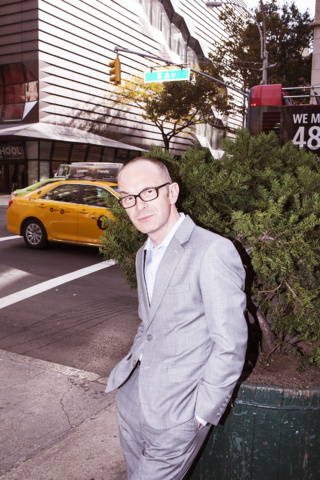At the end of this year Dean of Fashion at Parsons, Simon Collins is stepping down after six years in the post. As a designer and consultant himself, Collins brought his industry background to unite the fashion programs across the school, redesign the curriculum, steward the school’s move downtown and create collaborations with major fashion brands and corporations, all without having any experience in academia. Collins used his experience in working with brands like Nike, Polo Ralph Lauren, Zegna and more to guide the Fashion program at Parsons.
Inside Simon’s office, his bookshelf is stacked to the ceiling with fashion, art and design books. There are mannequins stationed around the room, draped in vintage red British army coats. The hum of the 5th avenue construction site can be heard loud and clear over our conversation, but that doesn’t seem to affect his cheery mood. His straightforward personality and quirky sense of humour are surprising for the Dean of one of the most influential fashion schools in the world. Dry and academic he is not. Collins calls his tenure at Parsons a “New York moment.” Though he’s now moving on, he says he’ll continue to volunteer his time and experience at the school for special projects, and, as he often notes, “You never leave Parsons.”
What are some of your favorite Parsons moments?
I remember one of the earliest projects with Louis Vuitton. We ended up taking the Vuitton collection and telling students they’ve got one day to repurpose the collection, which means if they need a pocket square, cut it out of this $5,000 jacket. The media started hearing about it. There were TV cameras looking through the windows. We were hacking it away, going at it, dyeing it, recreating it.
We designed the first MFA fashion program in the country, and I went to Milk Studios and said, “I want a show.” They said, “Of course, you have to show here!” When Cathy Horyn is in the front row with Donna Karan, you’re like, “Something’s going right here.”
What’s been one of the most challenging aspects of being Dean?
For all the positive things, there’s been some really nasty things that have happened. There’s been campaigns against me, anonymous abusive emails, hate letters and a petition to get rid of me. I definitely didn’t like it, but it makes you tougher. I don’t mind that.
Why is now the best time to leave?
I’ve been here six and a half years and we’ve done nothing but grow. We can’t grow forever and there comes a time when you have to level out a little bit and consolidate what you’ve done. This job is not for life. I don’t think it ever should be.
How have people reacted to you leaving?
When I announced I was leaving the other day, my friend who makes music, Henri Scars Struck, said to me, “I just did something for you,” and he made a song for me. What kind of job does that happen in?
How has fashion design changed through technology since you’ve been at Parsons?
There are a lot more avenues to make the industry function than there ever were before: publicity, of course, and social media. You can become famous before you ever leave school. And you better, because what are you doing if you’re not?
Is the fashion that Parsons designers produce art, or is it design?
I believe it’s most successful when it’s both. Not all of them are going to be both. Basics are not art. But John Galliano produces art. If you go and see Alexander McQueen’s Savage Beauty, that’s nothing less than art. But how do you define art?
Can you tell when a student is going to make it big?
The most important thing is a genuine vision. You can’t say you let your art speak for itself anymore. You’ve got to have such drive that you couldn’t possibly imagine doing anything else, because if you could, you should go and do it. To be a designer, you’ve got to be endlessly curious. You never know. The minute you think you know, you’re done.
How has Parsons’ recent move downtown affected the school’s culture?
I remember thinking, this isn’t about leaving the Garment Center. This is about expanding the Garment Center. The Garment Center reaches down here now, because we have 1,700 fashion students. Proenza and Alex are down in SoHo. Marc’s been there for years.
If you could teach any imaginary class at Parsons what would it be?
It would be design thinking, because I believe the essential elements of design thinking apply to everything, everywhere all the time.
How can design thinking be used in any industry?
If you run a company and you’re not embracing design thinking, it’s not going to work. I walked into a bank once and the bank teller was eating a burger. It did not make me feel good about my banking relationship. The only thing that unites everything Man has created is that it’s all designed. You’ve got to be empathetic.
What should the Parsons mascot be?
Clearly it should be matte black, minimal, cool, chic – a bipedal panther. It needs to be sharp and slightly acerbic. That would be the fashion mascot, and it wouldn’t do any sports apart from run really fast and look cool.
What inspires you?
I adore great design. It just makes me feel so nourished, and so wonderful. There are things I love in my office. I just rest my eyes on them for a while, and all the garbage I have to look at all the time and, I’m like, “I can fix all that now.” I just have to rest my eyes on something beautiful.
Credits
Text Kristen Bateman
Photography Brayden Olson
